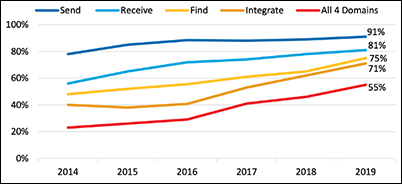But information blocking remains a barrier to complete information exchange, creating ongoing issues for clinical laboratories and pathology groups
Interoperability of electronic health records (EHRs) remains one the biggest challenges for clinical laboratories and anatomic pathology groups that must interface with the EHRs of their physician clients to enable electronic transmission of medical laboratory orders and test results.
Laboratory professionals will be pleased to know the most recent federal government report on hospital interoperability shows 55% of all hospitals can now send, receive, find, and integrate patient information from outside sources into their EHRs. This is an important milestone on the road to robust data exchange.
The Office of the National Coordinator for Health Information Technology (ONC) first began tracking hospital interoperability in 2014. This latest ONC report, titled, “Use of Certified Health IT and Methods to Enable Interoperability by U.S. Non-Federal Acute Care Hospitals, 2019,” released in January 2021 and based on data from 2019, represents the first time the percentage of hospitals achieving full interoperability crossed the 50% threshold, up from 46% in 2018 and 23% in 2014. Public health analyst Christian Johnson, MPH, PhD, and senior health economist Yuriy Pylypchuk, PhD, co-authored the report.
Other highlights from the ONC report:
- About 70% of hospitals reported integrating data into their EHR—a nearly 15% increase from 2018.
- A majority of hospitals used a mix of electronic and non-electronic methods to exchange summary of care records. However, use of electronic third-party methods, Health Information Service Providers (HISPs), health information exchange (HIE), and vendor networks increased in 2019.
The proportion of hospitals that used a national network to find (or query) patient health information increased by nearly 40% between 2018 and 2019.

David Burda, creator and leader of 4sight Health, a thought leadership and advisory company, has been a forceful advocate for healthcare interoperability, routinely stressing that patients cannot receive the optimum level of care from their providers as long as EHR vendors and health systems engage in information blocking.
In a blog post, Burda commented on the ONC report and outlined how far there still is to go. “Hospitals passed an important interoperability milestone in 2019, but the goal of reaching total hospital interoperability is still ways off.
“To be fair,” he added, “there were some other signs of progress in the new ONC report. The most significant, from a patient’s point of view, was the fact that in 2019, more hospitals were actively seeking patient health information from other providers and sources as part of how they routinely diagnose and treat patients. They’re not passively relying on data in their own EHR systems to make medical decisions.”
For example, Burda wrote:
- 73% of the hospitals said they struggle with exchanging patient information with other providers who use a different EHR system.
- 66% of the hospitals said they share patient information with other providers who don’t share patient health information with them.
- 59% of the hospitals said other providers’ EHR systems don’t have the capability to receive patient health information from them.

KLAS and CHIME are Optimistic about EHR Interoperability
Industry progress toward interoperability was also noted in a white paper titled, “Trends in EMR Interoperability,” co-authored by KLAS Research and the College of Healthcare Information Management Executives (CHIME). The authors found reasons for optimism, noting the rate of provider organizations achieving “deep interoperability” had doubled since 2017, with roughly two-thirds of provider organizations often or nearly always having access to needed records.
“The overall rate leaves much to be desired, but signs of progress are visible,” the authors wrote. Evidence of that progress includes improved data sharing with outside EHRs, a growing ability for ambulatory clinics and smaller hospitals to connect with larger organizations, and more widespread use of national networks to achieve information sharing.
“Since KLAS’ prior large-scale interoperability study in 2017, the market has made notable progress; access to outside records has increased, provider organizations are connecting to more critical exchange partners than ever, and the use of APIs offers new ways to facilitate data exchange in service of myriad use cases,” the report concludes. “Even with all this progress, there is still a significant opportunity for EMR (electronic medical record) vendors and provider organizations to partner effectively to help data exchange truly impact patient care. With additional work, the industry appears poised for improvement in this area going forward.”
Seema Verma says Interoperability is Improving
In an article she authored for Health IT News, titled, “How CMS Has Made Progress on Healthcare Interoperability,” Seema Verma, Administrator for the Centers for Medicare and Medicaid Services (CMS) during the Trump presidency, noted that great strides have been made in recent years toward the goal of complete interoperability.
“Technology is ever evolving, and our work will constantly evolve, but our efforts have laid a foundation for future policy that will enable the secure and interoperable exchange of healthcare information, drive value-based care in America, and give patients and doctors the information they need,” she wrote.
For clinical laboratories and anatomic pathology groups, the road to interoperability remains littered with a few potholes, but speed bumps are disappearing, which may signal a time in the not-too-distant future when clinical laboratories and pathology groups will easily interface electronically with physicians, hospitals, and other providers to receive test orders and transmit test results.
—Andrea Downing Peck
Related Information:
Catching Up on Hospital Interoperability
Use of Certified Health IT and Methods to Enable Interoperability by U.S. Non-Federal Acute Care Hospitals, 2019
CMS Has Made Progress on Healthcare Interoperability
Interoperability Is in the Eye of the Patient Information Blocker



